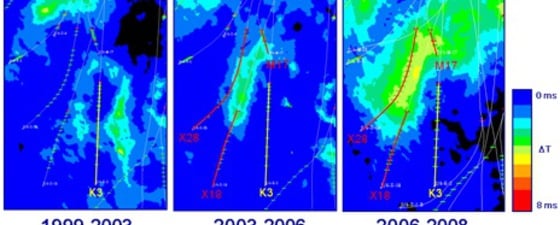MNR and exploration in the Vøring Basin
 The prospect Dalsnuten is a result of Late Cretaceous rifting and rotation of fault blocks within the Gjallar ridge. Late Cretaceous sands are expected to contain hydrocarbons indicated by the “flatspots” in this example. Hopefully the well will reach the Jurassic and verify the presence of an Upper Jurassic source rock.
The prospect Dalsnuten is a result of Late Cretaceous rifting and rotation of fault blocks within the Gjallar ridge. Late Cretaceous sands are expected to contain hydrocarbons indicated by the “flatspots” in this example. Hopefully the well will reach the Jurassic and verify the presence of an Upper Jurassic source rock. Mid Norwegian shelf with main structural elements and Mid Norwegian Regional (MNR) seismic coverage. The line coloured in red shows the line displayed on previous pages. Illustration: Fugro
Mid Norwegian shelf with main structural elements and Mid Norwegian Regional (MNR) seismic coverage. The line coloured in red shows the line displayed on previous pages. Illustration: Fugro Overburden of top Jurassic time depth converted with stacking velocities. Illustration: FugroThe first two deep water wells in the Vøring basin were drilled by Exxon on the Utgard High (former Bodø High) in 1987 and 1991. The primary targets for both wells were the Middle Jurassic reservoirs. To the industry’s surprise, both wells failed to reach Jurassic sediments. The first well was terminated half way into the third igneous intrusion and the second well was terminated in the Late Cretaceous.
Overburden of top Jurassic time depth converted with stacking velocities. Illustration: FugroThe first two deep water wells in the Vøring basin were drilled by Exxon on the Utgard High (former Bodø High) in 1987 and 1991. The primary targets for both wells were the Middle Jurassic reservoirs. To the industry’s surprise, both wells failed to reach Jurassic sediments. The first well was terminated half way into the third igneous intrusion and the second well was terminated in the Late Cretaceous.
Although no hydrocarbons were encountered in any of the wells, the geological information from the first well had a significant impact on later exploration in the Vøring Basin.
The Campanian sandstone penetrated was very important to the understanding of the Nise sand deposition and distribution in the basin. This formed the basis for the Nyk-discovery made by BP 6 years later. The thermal effect of igneous intrusions could not have been modelled without the information from this well and this continues to be one of the major challenges explorationists face on the Atlantic margin.
Seismic imaging at the time of drilling these wells was poor, and the complexity of the Utgard High was better imaged by gravity data than seismic. During the last 20 years a significant effort has been made to improve the quality of seismic data in the region and with new long offset data there is a much better understanding of the regional development in the Vøring Basin.
Fugro commenced the acquisition of the Mid Norway Regional survey (MNR) in 2004. To date, more than 67,000 km of seismic has been acquired and processed in co-operation with our partner TGS, and further phases are planned. The goal is to provide a consistent 4×4 km grid over the entire shelf to highlight areas for further 3D acquisition, with reduced exploration cost and risk.
Another challenge in the exploration of the Vøring Basin has been the lack documentation of other effective source rocks than in the Late Jurassic. Unfortunately, the deep and early burial of this sequence makes it a questionable source for oil in most of the region. In addition, regional seismic data have not had good enough imaging to allow a proper tie of the Jurassic section into the western part of the basin.
With the new long offset MNR data the deep structures in the basin can be mapped with confidence and a Top Jurassic map produced. This surface has significant relief. Deep grabens and local highs emerge, providing a series of exploration targets.
After 30 years of data gathering and more than 20 years after the drilling of the Utgard High, new data has again made Jurassic rocks a viable target in the Vøring Basin. Although the Jurassic is buried too deep for conventional drilling today, many local highs are present along the western margin. Dalsnuten is one of these structures and will be tested later this year. Whether this well will give the long sought after oil discovery in the Vøring Basin or not remains to be seen. However, as with the wells on the Utgard High, this well will provide valuable geological information for future exploration of this area.





